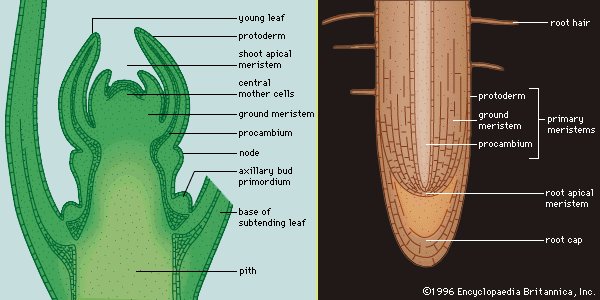
PUMPA - SMART LEARNING
எங்கள் ஆசிரியர்களுடன் 1-ஆன்-1 ஆலோசனை நேரத்தைப் பெறுங்கள். டாப்பர் ஆவதற்கு நாங்கள் பயிற்சி அளிப்போம்
Book Free DemoC. Classification based on function:
According to Haberlandt, apical meristem is divided into three regions.
Based on their function, meristems have been classified into three types, namely:
a) Protoderm meristem
b) Procambium meristem
c) Ground Meristem

Root and shoot apical meristems
Image credits: https://www.britannica.com/science/meristem
1. Protoderm meristem:
Location: It is located around the outside of the stem.
It is a thin outermost layer of the meristem in embryos, which give rise to the epidermal tissue system and develops into epidermis, stomata and hairs. It helps to protect the plant from mechanical injury.
2. Procambium meristem:
Location: The procambium is situated next to the protoderm.
It is composed of narrow, elongated, meristematic cells that give rise to the vascular tissues like the primary xylem, primary phloem and vascular cambium.
3. Ground meristem:
It is also known as a fundamental meristem. It is composed of large, thick-walled cells which develop to form ground tissue system, e g.,hypodermis, endodermis, pericycle, cortex, rays and pith. Parenchyma, collenchyma, and sclerenchyma form the ground tissue system in plants
D. Classification based on the plane of cell division:
The plane of meristematic tissue division and its growth pattern is essential to control the mode of growth.
Based on the mode of growth, tissues can be classified into three types, namely:
a) Mass meristem
b) Rib or file meristem
c) Plate meristem
1. Mass meristem:
They are also known as block meristem. In this type of meristem, cell divisions occur in all possible planes, which will increase the plant body's volume. In meristems of cortex and pith, we can observe this kind of plane division.
2. Rib meristem:
It is also known as file meristem. The cells divide only one plane and forms rows or columns of cells. In the formation of filaments in algae, we can observe this kind of plane division.
3. Plate meristem:
These cells divide intwo planes resulting in an increase in the area of an organ. During this division, plate-like structures are formed. Formation of leaf blade takes place by the activity of this meristem.
Functions of meristematic plant:
Meristematic tissues are actively dividing tissues of the plant. They are responsible for the growth of the plant. There are two ways of growth of the plant.
i) Primary growth: It is controlled by shoot or root apical meristems, which are normally found in the tips of the plants, and is responsible for the elongation of the plant
ii) Secondary growth: It is controlled by the lateral meristems such as vascular cambium and cork cambium and is responsible for the plant's thickness.

Primary and secondary growth of vascular bundle
Reference:
https://www.shutterstock.com/image-vector/primary-growth-shoot-vector-1358959055
https://www.flickr.com/photos/blueridgekitties/4425262405